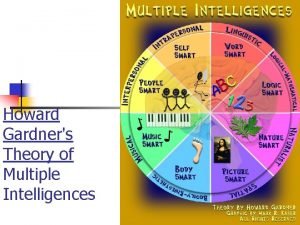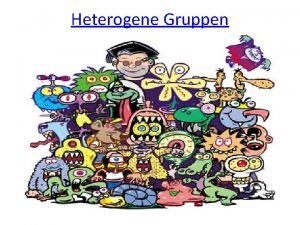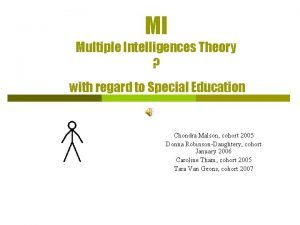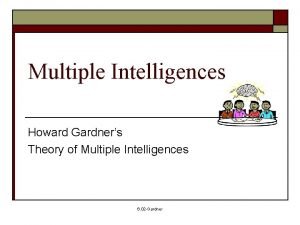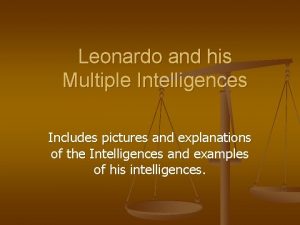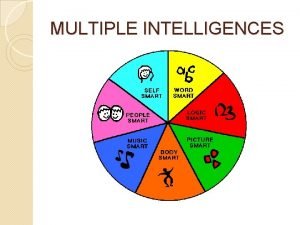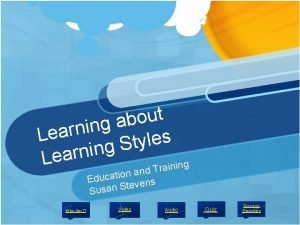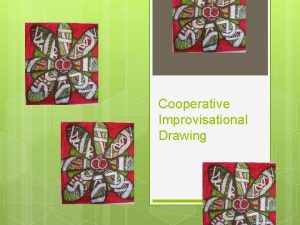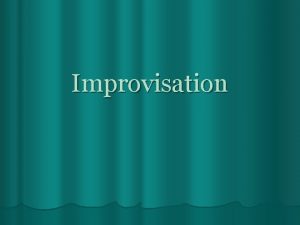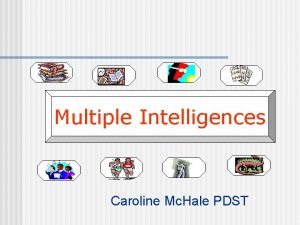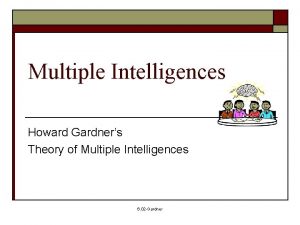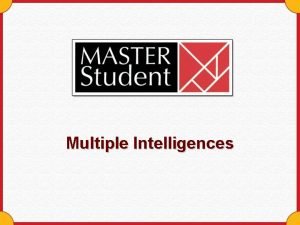Cooperative Improvisational Drawing Multiple Intelligences Cooperative Improvisation For














- Slides: 14

Cooperative Improvisational Drawing Multiple Intelligences

Cooperative Improvisation For this learning experience, students spend time choosing and then learning about a subject before they make an attempt at art making. Materials Used: 1 large sheet of paper, soft charcoal sticks and pencils, erasers, water soluble oil pastels, water cups, and paint brushes.

STEP ONE Choose a subject. Discuss paintings by Richard Poussette-Dart.

Multiple Intelligence Everyone has a learning and performing strength and weakness. Some people are good at many things, but very strong or weak in a couple of others. What are your learning strengths and weaknesses? Give examples.

Multiple Intelligences Linguistic = Word Smart Mathematical = Number Smart Spatial/Visual = Picture Smart Interpersonal = People Smart Intrapersonal = Self-Smart Bodily-Kinesthetic = Body Smart Musical = Music Smart Naturalistic = Nature Smart Emotional = Stress Smart

Richard Poussette-Dart

Jasper Johns

Step One continued… Discuss Jasper Johns’ statement. “Take an object. Do something to it. Do something else to it……”

STEP TWO Teacher demonstration of improvisational drawing with charcoal and erasers on paper. Students practice improvisational drawing in their DW and on newsprint.

STEP THREE The students will record three important facts about the agreed subject and draw 3 quick thumbnail sketches in their DWs for homework. Whole group discussion about DW homework on the following period. The students will begin formatting their mental approach for the drawing.

STEP FOUR (Begin the final drawing) 1) Choose your group. 2) Draw the subject ( a light bulb or silhouette of a head in profile)largely onto a large piece of paper. 3) Section off the subject one section for each group member. 4) Draw symbols in your section for 10 minutes and rotate one space to the left. 5) Draw over and into your new section. You may modify, alter, accentuate, and add to what the previous artist has done. Draw for 5 to 10 minutes before rotating left again.

Final Project Process Con’t… 6) After symbols fill each section, erase out thick lines that make geometric and biomorphic shapes. 7) Outline these shapes with charcoal. 8) After each section has been filled with these thick lines and shapes, erase new lines on top and through what is in each section. With the newly erased lines, have them connect to the adjacent sections in order to unify the piece.

Final Project Process Con’t… 9) Outline and blend with charcoal. Be careful to not lose your lighter values and make everything too gray and black. 10) Write a statement about the subject around the shape of the bat. 11) Color a 2 to 3 inch swathe of water-soluble oil pastels around the bat. 12) Add water to the color with paintbrushes and blend it out to edges of the paper. 13) Outline the negative space inside the bat with color and blend with water. 14) Sign it on the back after drying and hang!

Example of a finished product:
 Montessori for multiple intelligences
Montessori for multiple intelligences Multiple intelligences in the classroom
Multiple intelligences in the classroom Bodily kinesthetic intelligence
Bodily kinesthetic intelligence Gardners multiple intelligence test
Gardners multiple intelligence test Gardner's multiple intelligences
Gardner's multiple intelligences Multiple intelligences
Multiple intelligences Bgfl multiple intelligences
Bgfl multiple intelligences Kids watching movie clipart
Kids watching movie clipart Howard gardners theory of multiple intelligences
Howard gardners theory of multiple intelligences Leonardo da vinci multiple intelligences
Leonardo da vinci multiple intelligences Www. edutopia.org/multiple-intelligences-introduction
Www. edutopia.org/multiple-intelligences-introduction Edutopia multiple intelligence quiz
Edutopia multiple intelligence quiz Learning styles and multiple intelligences
Learning styles and multiple intelligences Intelligence interpersonal
Intelligence interpersonal Multiple intelligences and differentiated instruction
Multiple intelligences and differentiated instruction



